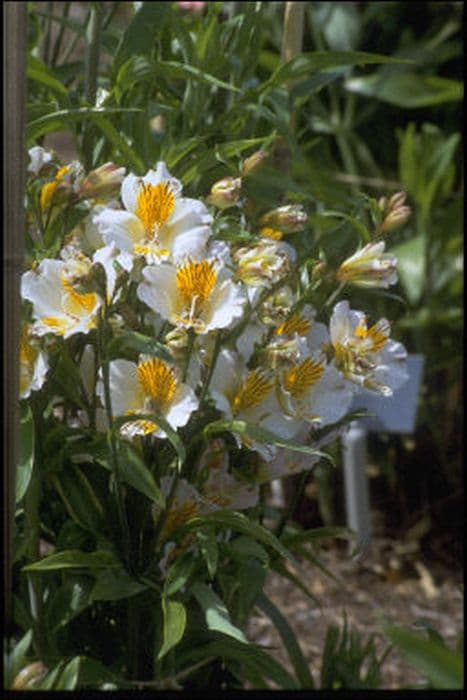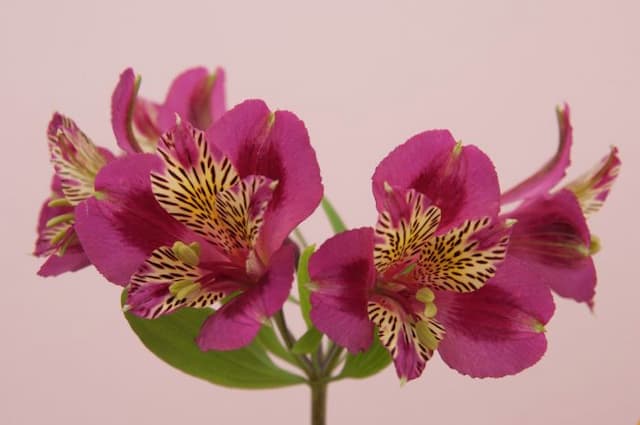Alstroemeria Inca Coral = 'Konocoral' (Inca Series)
![Peruvian lily [Inca Coral]](/_next/image?url=https%3A%2F%2Fplants-admin.emdemapps.com%2Fimages%2Fplants%2F%2Fimages%2F604b5b79b85ce.png&w=3840&q=75)
ABOUT
The Alstroemeria Inca Coral, part of the Inca Series, is a stunning perennial boasting a vibrant display of flowers and foliage. The plant is well-known for its striking blooms that have a unique color combination of coral pink petals accented with yellow throats and dark burgundy streaks. Each bloom consists of six slightly curved petals that create a trumpet-like shape, contributing to its exotic appearance. Adorning the top of slender, upright stems, the flowers are often clustered together in groups, providing a lush, full look. These stems emerge from a base of dense, linear green leaves that are lance-shaped and can have a slightly twisted form, giving the plant an attractive and lush green background against which the colorful flowers stand out prominently. The remarkable coloration of the Alstroemeria Inca Coral makes it a popular choice for gardeners and florists alike. The plant is highly regarded for its longevity in both the garden and cut flower arrangements, making it valuable for its decorative appeal. It typically blooms from late spring to fall, ensuring a long-lasting period of color and beauty in the garden. Overall, Alstroemeria Inca Coral offers a dazzling display with its harmonious blend of bold hues and interesting patterns.
About this plant
 Names
NamesFamily
Alstroemeriaceae
Synonyms
Peruvian Lily, Lily of the Incas, Inca Lily
Common names
Alstroemeria Inca Coral = 'Konocoral' (Inca Series).
 Toxicity
ToxicityTo humans
The Peruvian Lily, while not considered highly toxic, can cause mild irritation if ingested. Symptoms of ingestion can include nausea, vomiting, and diarrhea. It is advisable to keep the plant out of reach of children who might be tempted to eat it due to its attractive flowers.
To pets
Peruvian Lily can be irritating to pets if ingested. For cats and dogs, consumption of the plant may result in mild gastrointestinal symptoms such as vomiting or diarrhea. While it is not regarded as highly toxic, it is still recommended to prevent pets from eating the plant to avoid any potential discomfort.
 Characteristics
CharacteristicsLife cycle
Perennials
Foliage type
Evergreen
Color of leaves
Green
Flower color
Coral
Height
2 feet (60 cm)
Spread
1 foot (30 cm)
Plant type
Herb
Hardiness zones
7
Native area
South America
Benefits
 General Benefits
General Benefits- Long Blooming Season: 'Konocoral' typically flowers from late spring to early fall, providing a prolonged display of color in the garden.
- Vibrant Colors: The plant produces vivid coral-colored blooms, which add a bright and cheerful aspect to any landscape.
- Attracts Pollinators: The flowers attract bees, butterflies, and other beneficial insects, which help pollinate other plants in the garden.
- Low Maintenance: Inca lilies are relatively easy to care for, requiring minimal attention once established in the right conditions.
- Drought Tolerance: Once established, they are quite tolerant of dry conditions, making them suitable for water-wise gardens.
- Great Cut Flowers: The blooms of 'Konocoral' have a long vase life, making them excellent choices for floral arrangements.
- Cold Resistance: They are fairly resistant to colder temperatures, which allows them to be grown in a range of climates.
- Perennial Growth: As a perennial, this plant will return year after year, providing long-term value in the garden.
- Versatile Planting Options: Inca lilies can be planted in borders, containers, or as a part of a cut flower garden.
 Medical Properties
Medical PropertiesThis plant is not used for medical purposes.
 Air-purifying Qualities
Air-purifying QualitiesThis plant is not specifically known for air purifying qualities.
 Other Uses
Other Uses- Greeting Cards Embellishment: The vibrant flowers of the Alstroemeria can be pressed and used to adorn handmade greeting cards, providing a unique and personal touch.
- Crafting Bookmarks: Pressed Alstroemeria flowers can be laminated to create decorative bookmarks, ideal for book lovers looking for a splash of color in their reading experience.
- Edible Cake Decorations: The edible petals of Alstroemeria can be crystallized with egg whites and sugar and used as natural, colorful toppers for cakes and desserts.
- Natural Dye: The colorful petals of the Alstroemeria can be boiled to extract natural dyes for fabric, offering a range of hues from oranges to pinks.
- Artistic Inspiration: Artists can use the striking look of Alstroemeria as a subject for paintings, drawings, and photography, capturing the beauty of its symmetry and colors.
- Table Setting Decoration: Fresh Alstroemeria flowers can be used to create attractive centerpieces or to enhance place settings for dinners and special occasions.
- Educational Tool: The flower can be used to teach botany and horticulture students about monocot plant structures, propagation, and breeding practices.
- Fish Tank Beautification: Although not an aquatic plant, synthetic replicas of Alstroemeria can be used as vibrant, non-toxic decorations in aquariums.
- Flower Crowns and Hair Accessories: The blooms and leaves can be woven into hair clips, bands, and flower crowns for festivals, weddings, or just for a summery look.
- Floral Photography Backdrops: Large prints or fabric featuring the Alstroemeria flower can serve as vibrant backdrops for portrait photography.
Interesting Facts
 Feng Shui
Feng ShuiThe plant_name is not used in Feng Shui practice.
 Zodiac Sign Compitability
Zodiac Sign CompitabilityThe plant_name is not used in astrology practice.
 Plant Symbolism
Plant Symbolism- Friendship - Alstroemeria is often associated with strong, lasting friendships, symbolizing the bonds that endure despite life's challenges.
- Devotion - Its multiple blooms from a single stem represent the many ways one can remain devoted to loved ones, reflecting the mutual support in relationships.
- Wealth and Prosperity - With its lush, full blooms, the Alstroemeria signifies abundance and the wish for a prosperous life.
- Fortune - Given as a gift, it often symbolizes the hope for good fortunes to come the recipient’s way.
- Achievement of aspirations - The plant's ability to grow and flourish symbolizes the realization of dreams and the achievement of personal goals.
 Water
WaterThe Peruvian Lily should be watered deeply so that the water reaches the roots, approximately once a week. Consistency is key; it's crucial to ensure the soil remains moist but not waterlogged. During the peak of summer, the plant may require more frequent watering, potentially twice a week, depending on the heat and humidity. If potted, it is important to check that the pot has proper drainage to avoid water accumulation. A good rule of thumb is to provide about one gallon of water weekly to sustain optimal growth, adjusting as necessary for weather conditions.
 Light
LightPeruvian Lilies thrive in full sun to partial shade conditions. They perform best when they receive at least six hours of sunlight daily, so a spot that gets morning sun and some afternoon shade would be ideal. Too much harsh afternoon sun might stress them, so if you live in a particularly hot climate, ensure they are protected during the peak heat hours.
 Temperature
TemperaturePeruvian Lilies are quite hardy and can tolerate a range of temperatures, but perform best in conditions between 65 and 75 degrees Fahrenheit. They can survive minimum temperatures down to around 23 degrees Fahrenheit but not without potential damage. To encourage blooming and strong growth, maintain as stable a temperature as possible within their ideal range.
 Pruning
PruningPruning Peruvian Lilies is important to remove spent flowers and encourage reblooming. Cut back stems that have finished flowering to the base to stimulate new growth. It is best to prune regularly throughout the blooming season. Additionally, at the end of the season, prune any damaged or diseased stems to maintain plant health and prepare it for the next growing season.
 Cleaning
CleaningAs needed
 Soil
SoilPeruvian Lily thrives best in a well-draining soil mix with loamy or sandy composition, enriched with organic matter. The ideal pH for this plant ranges from slightly acidic to neutral, around 6.0 to 7.5.
 Repotting
RepottingPeruvian Lily should be repotted every two to three years to refresh the soil and provide room for growth. Spring is the best time for repotting this plant.
 Humidity & Misting
Humidity & MistingPeruvian Lily prefers moderate humidity levels. Aim for a humidity level around 40-60% for optimal growth conditions.
 Suitable locations
Suitable locationsIndoor
Place in bright, indirect light and ensure proper drainage.
Outdoor
Plant in partial shade and shelter from harsh winds.
Hardiness zone
7-10 USDA
 Life cycle
Life cycleThe Peruvian Lily 'Konocoral' begins its life as a tuber, which, when planted in well-drained soil and given adequate warmth, will sprout into a young seedling. As the seedling grows, it develops into a clump-forming perennial with lance-shaped leaves, eventually reaching maturity where it starts to produce its distinctive funnel-shaped pink and yellow flowers predominantly in summer. After the flowering phase, the plant enters a period of pollination, often facilitated by insects, leading to the formation of capsules containing seeds. When the seeds are mature, they are dispersed from the capsule, potentially giving rise to new plants if conditions are suitable. During harsh conditions or winter months, the plant may enter a dormant phase, where growth slows down or ceases until favorable conditions return. The Peruvian Lily can also propagate vegetatively through division of the rhizome, allowing for the creation of genetically identical offspring which will then repeat the lifecycle.
 Propogation
PropogationPropogation time
Spring to Summer
The Alstroemeria Inca Coral, commonly known as Peruvian Lily or Lily of the Incas, is typically propagated by division. This process is best done in the spring as new growth begins to emerge. To propagate by division, carefully lift the clump of tubers from the ground with a spade, ensuring minimum damage to the tubers. Gently tease apart the clumps into smaller sections, each with a few shoots and ample root system. These sections can then be replanted at a spacing of about 12 to 18 inches (approximately 30 to 45 centimeters) apart, ensuring they are at the same depth they were previously growing. Water them in well and maintain moisture until the new plants are established. Division helps to rejuvenate clumps that have become too dense and also provides a good quantity of new plants for expanding the garden or sharing with fellow gardeners.





![Peruvian lily [H.R.H. Princess Alice]](/_next/image?url=https%3A%2F%2Fplants-admin.emdemapps.com%2Fimages%2Fplants%2F%2Fimages%2F604b55e81c8b0.png&w=640&q=75)

![Peruvian lily [Inca Exotica]](/_next/image?url=https%3A%2F%2Fplants-admin.emdemapps.com%2Fimages%2Fplants%2F%2Fimages%2F604b5ec0e34a9.png&w=640&q=75)
![Peruvian lily [Inca Milk]](/_next/image?url=https%3A%2F%2Fplants-admin.emdemapps.com%2Fimages%2Fplants%2F%2Fimages%2F604b5f14b0b6a.png&w=640&q=75)
![Peruvian lily [Inticancha Dark Purple]](/_next/image?url=https%3A%2F%2Fplants-admin.emdemapps.com%2Fimages%2Fplants%2F%2Fimages%2F604b5381bb78f.png&w=640&q=75)